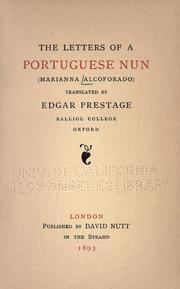Country France Genre Epistolary fiction Originally published 1669 Publisher Claude Barbin | Publication date 1669 | |
 | ||
Original title Les Lettres Portugaises Classical Studies books Letters from a Peruvian, The Princess of Cleves (C, Julie - or the New Heloise, Dangerous Acquaintances, Micromégas | ||
The Letters of a Portuguese Nun (French: Les Lettres Portugaises, literally The Portuguese Letters), first published anonymously by Claude Barbin in Paris in 1669, is a work believed by most scholars to be epistolary fiction in the form of five letters written by Gabriel-Joseph de La Vergne, comte de Guilleragues (1628–1685), a minor peer, diplomat, secretary to the Prince of Conti, and friend of Madame de Sévigné, the poet Boileau, and the dramatist Jean Racine.
Contents
Publication
From the start, the passionate letters, in book form, were a European publishing sensation (in part because of their presumed authenticity), with five editions in the collection's first year, followed by more than forty editions throughout the 17th century. A Cologne edition of 1669 stated that the Marquis de Chamilly was their addressee, and this was confirmed by Saint-Simon and by Duclos, but, aside from the fact that she was female, the author's name and identity remained undivulged.
The original letters were translated in several languages, including the German, Portugiesischen Briefen (Rainer Maria Rilke) and Dutch, Minnebrieven van een Portugeesche non (Arthur van Schendel). The letters, in book form, set a precedent for sentimentalism in European culture at large, and for the literary genres of the sentimental novel and the epistolary novel, into the 18th century, such as the "Lettres persanes " by Montesquieu (1721), "Lettres péruviennes" by Françoise de Graffigny (1747) and "Julie, ou la nouvelle Héloïse" by Jean-Jacques Rousseau (1761).
Also in 1669, the original publisher, Claude Barbin, published a sequel, again said to have been written by a "Portuguese lady of society," with the addition of seven new letters to the original five. Later, several hack writers wrote serial stories on the same theme. To exploit the letters' popularity, sequels, replies, and new replies were published in quick succession and were distributed, in translation, throughout Europe.
The Letters of a Portuguese Nun were written in the same style as "The Heroides", a collection of fifteen epistolary poems composed by Ovid, and "Lettres d'Héloise à Abélard", a medieval story of passion and Christian renunciation. They form a monologue beginning in amorous passion and slowly evolving, through successive stages of faith, doubt, and despair, toward a tragic end.
Authorship
Until the 20th century, the letters were often ascribed to a 17th-century Franciscan nun in a convent in Beja, Portugal, named in 1810 as Mariana Alcoforado (1640–1723). The letters were said to have been written to her French lover, Noel Bouton, Marquis de Chamilly (1635–1715), who came to Portugal to fight on behalf of the Portuguese in the Portuguese Restoration War from 1663-1668. The young nun was said to have first seen the young officer from her window, the now-locally famous "janela de Mértola," or "window of Mértola."
The attribution to Gabriel-Joseph de la Vergne, Comte de Guilleragues, was first put forward by F. C. Green in 1926, and, later, in 1953, 1961, and 1962, by Leo Spitzer and Jacques Rougeot and Frédéric Deloffre, respectively. It is now generally recognised that the letters were not a verbatim translation from the Portuguese, but were in fact a work of fiction by the Comte de Guilleragues, himself.
However, the 2006 book Letters of a Portuguese Nun: Uncovering the Mystery Behind a 17th Century Forbidden Love by Myriam Cyr argues that Mariana Alcoforado did, in fact, exist — and that, as an educated nun of the period, she could have written the letters; that the letters show characteristics suggesting a Portuguese original, and that Mariana was, in fact, their author. None of the arguments presented by Myriam Cyr, however, differs significantly from the 19th century debate on the authenticity of the work, and the bulk of the critical evidence continues to favor the thesis of Guilleragues's authorship.
In the 17th century, the interest in the Letters was so strong that the word "portugaise" became synonymous with "a passionate love-letter."
